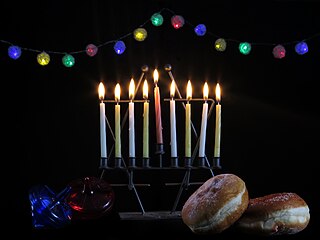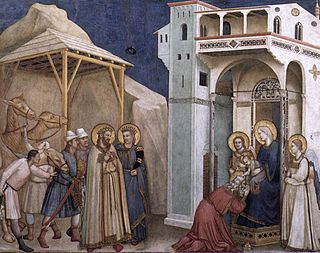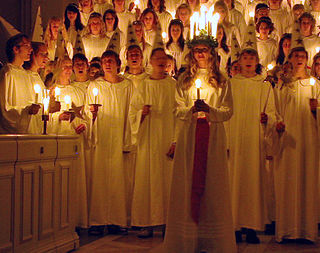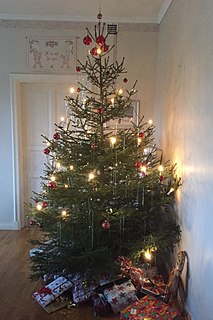
Hanukkah, also known as the Festival of Lights, is a Jewish festival commemorating the recovery of Jerusalem and subsequent rededication of the Second Temple at the beginning of the Maccabean revolt against the Seleucid Empire in the 2nd century BCE.

A Christmas tree is a decorated tree, usually an evergreen conifer, such as a fir, spruce, or pine, or an artificial tree of similar appearance, associated with the celebration of Christmas, originating in Germany associated with Saint Boniface. The custom was developed in medieval Livonia, and in early modern Germany where German Protestant Christians brought decorated trees into their homes. It acquired popularity beyond the Lutheran areas of Germany and the Baltic governorates during the second half of the 19th century, at first among the upper classes.

Advent is a season of the liturgical year observed in most Christian denominations as a time of expectant waiting and preparation for both the celebration of the Nativity of Christ at Christmas and the return of Christ at the Second Coming. Advent is the beginning of the liturgical year in Western Christianity, and is part of the wider Christmas and holiday season.

Christmas Eve is the evening or entire day before Christmas Day, the festival commemorating the birth of Jesus. Christmas Day is observed around the world, and Christmas Eve is widely observed as a full or partial holiday in anticipation of Christmas Day. Together, both days are considered one of the most culturally significant celebrations in Christendom and Western society.

A wreath is an assortment of flowers, leaves, fruits, twigs, or various materials that is constructed to form a ring.

The Twelve Days of Christmas, also known as Twelvetide, is a festive Christian season celebrating the Nativity of Jesus. In some Western ecclesiastical traditions, "Christmas Day" is considered the "First Day of Christmas" and the Twelve Days are 25 December to 5 January, inclusive, with 6 January being a "thirteenth day" in some traditions and languages. However, 6 January is most often considered Twelfth Day/Twelfth Night with the Twelve Days "of" Christmas actually after Christmas Day from 26 December to 6 January. For many Christian denominations—for example, the Anglican Communion and Lutheran Church—the Twelve Days are identical to Christmastide, but for others, e.g., the Roman Catholic Church, Christmastide lasts longer than the Twelve Days of Christmas.

The Advent wreath, or Advent crown, is a Christian tradition that symbolizes the passage of the four weeks of Advent in the liturgical calendar of the Western church. It is traditionally a Lutheran practice, although it has spread to many other Christian denominations.

Christmastide is a season of the liturgical year in most Christian churches. In some Christian denominations, Christmastide is identical to Twelvetide, a similar concept.

An Advent calendar is a special calendar used to count the days of Advent in anticipation of Christmas. Since the date of the First Sunday of Advent varies, falling between November 27 and December 3 inclusive, many Advent calendars, especially those that are reusable, often begin on December 1, although those that are produced for a specific year start from the First Sunday of Advent and thus include the last few days of November that begin the liturgical season of Advent. The Advent calendar was first used by German Lutherans in the 19th and 20th centuries, and has since then spread to other Christian denominations.

Christmas lights are lights often used for decoration in celebration of Christmas, often on display throughout the Christmas season including Advent and Christmastide. The custom goes back to when Christmas trees were decorated with candles, which symbolized Christ being the light of the world. The Christmas trees were brought by Christians into their homes in early modern Germany.

Saint Lucy's Day, also called the Feast of Saint Lucy, is a Christian feast day observed on 13 December. The observance commemorates Lucia of Syracuse, an early-4th-century virgin martyr under the Diocletianic Persecution, who according to legend brought food and aid to Christians hiding in the Roman catacombs, wearing a candle lit wreath on her head to light her way and leave her hands free to carry as much food as possible. Her feast day, which coincided with the shortest day of the year prior to calendar reforms, is widely celebrated as a festival of light. Falling within the Advent season, Saint Lucy's Day is viewed as a precursor of Christmastide, pointing to the arrival of the Light of Christ in the calendar on Christmas Day.

The observance of Christmas around the world varies by country. The day of Christmas, and in some cases the day before and the day after, are recognized by many national governments and cultures worldwide, including in areas where Christianity is a minority religion. In some non-Christian areas, periods of former colonial rule introduced the celebration ; in others, Christian minorities or foreign cultural influences have led populations to observe the holiday.

A Christmas decoration is any of several types of ornamentation used at Christmastime and the greater holiday season. The traditional colors of Christmas are pine green (evergreen), snow white, and heart red. Gold and silver are also very common, as are other metallic colours. Typical images on Christmas decorations include Baby Jesus, Father Christmas, Santa Claus, and the star of Bethlehem.

Jul or jol is the term used for the Christmas holiday season in Scandinavia and parts of Scotland. Originally, "jul" was the name of a month in the old Germanic calendar. The concept of "jul" as a period of time rather than a specific event prevailed in Scandinavia; in modern times, "Jul" is a period of time stretching from the fourth sunday before Christmas eve, December 24, to (traditionally) mid-January at the date of Epiphany with december month and Christmas, and the week up to New Year, as its highlight. The modern English yule and yuletide are cognates with this term.

The Christmas season, also called the holiday season, or the festive season, is an annually recurring period recognized in many Western and other countries that is generally considered to run from late November to early January.

Advent Sunday, also called the First Sunday of Advent or First Advent Sunday, among the Western Christian Churches, is the first day of the liturgical year and the start of the season of Advent.

Christmas in Ireland traditionally begins on 8 December, the Feast of the Immaculate Conception, with many putting up their decorations and Christmas trees on that day, and runs through until 6 January, or Little Christmas. The greeting for "Happy Christmas" in Irish is Nollaig Shona Duit [singular] or Nollaig Shona Daoibh [plural]. The literal translation of this is "Happy Christmas to you".

Christmas is celebrated throughout December and traditionally until St. Knut's Day on January 13. The main celebration and the exchange of gifts in many families takes place on Christmas Eve, December 24. The Feast of St. Lucy, a high point in the Swedish Christmas season, is celebrated during Advent, on December 13.

The hanging of the greens is a Western Christian ceremony in which many congregations and people adorn their churches, as well as other buildings, with Advent and Christmas decorations. This is done on or directly before the start of the Advent season, in preparation for Christmastide. The service involves the placement of evergreen vegetation in the parish. Items such as the evergreen wreath, in Christianity, carry the religious symbolism of everlasting life, a theological concept within that faith. As such, during the liturgy, "Biblical passages and other readings help explain the significance of the holly, the cedar, the Advent wreath, the Chrismon tree, and any other special decorations". Christmas trees are frequently erected during the hanging of the greens, although they are sometimes left bare until Christmas Eve.

Christmas in France is a major annual celebration, as in most countries of the Christian world. Christmas is celebrated as a public holiday in France on December 25, concurring alongside the United States and other countries.





















